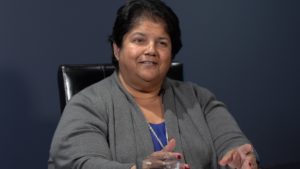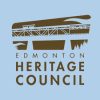
Joy Correia was born in Kenya to parents of Indian ancestry. Her family arrived in Canada when she was five, and her parents taught for three years on the Blood Reserve near Cardston, and then in Taber. She did her primary and secondary schooling in those two communities. After finishing school, she came to Edmonton and graduated in Science at the University of Alberta in 1982 and was soon hired at the University as a technician in the Department of Genetics.
Correia has been a member or staffer of the Non-Academic Staff Association (NASA)1 at the University of Alberta since she started her job there, and became NASA president in 2002; since 2007, she’s served as Labour Relations Officer. She mentions that working in the union itself opened her eyes to the role of unions, reflecting that, “neither of [my parents], when they had issues with their employer, reached out to their unions for representation. I just shake my head at that now as I realize how they struggled through those issues.”
In 1984, she purchased a house in Mayfield, moved there with her family, and still resides in the neighbourhood. Mayfield is a subdivision developed in 1954 when the area was part of the Town of Jasper Place, which was then amalgamated into the City of Edmonton in 1964. As she explains it:
We always called it Mayfield; I don’t think I ever understood it as being part of Jasper Place. But now that you say that, that makes perfect sense to me, that it would be considered part of Jasper Place. I always just call it the old West End, and I include all that area kind of west of 149th Street.
A colleague of hers who had connections to Mayfield told her stories of how the area used to be all swamp and that the park in the neighbourhood was named after bush pilot, Wop May. Someone else told her that “Mayfield was the first ever developer-built neighbourhood in Edmonton.”
The Correia children – born at the Misericordia Hospital in West Meadowlark Park just south of Mayfield – did their schooling till Grade 9 at Holy Cross School in Canora because of its French Immersion Program.
Correia mentions that Mayfield has a “very good sense of neighbourhood”, and that it’s changed quite a bit since 1984. When they first arrived, their neighbours were mostly of European heritage – Ukrainian, Polish, or British – and were the original owners of the houses built in 1954:
Lovely people. Very good sense of neighbourhood, which I loved about the neighbourhood. I think because we had that sound wall that goes around Mayfield Road on the west and north of us, there’s only three or four entrances into the neighbourhood, so it really gave it… and I think it’s smaller too in land area, so the number of homes was smaller. You really had a sense of community, like a small town. It also had quite a vibrant Community League, so there’s always things that were going on. Of course, there are two schools there, primary schools, from both Edmonton School Board and Edmonton Catholic School Board. They’re just a stone’s throw away.
Correia also mentions that Indigenous families live in the neighbourhood, and her children played hockey with them. Starting in the ‘80s and ‘90s, when she became more involved in community activities with the Mayfield Community League, she began to notice more and more cultural diversity.
When asked if she or her family had faced racism or discrimination in the community, she replies, “No, I think I’ve always had sort of these kind of around-me conversations,” but that her mother had had a disturbing conversation with one of her neighbours, related in the attached video.
Most of the dwellings in the neighbourhood are single-family, she says, though there are some townhouses and four or five walk-up apartment blocks, which have now been converted into condominiums. This type of housing stock, she says, lends itself to stability in the community, explaining:
I think there’s still a number of immigrant families that moved to the community because the price point is decent, the houses are 1,000 square feet, and there’s a little bit of a yard. It’s not a huge investment to buy something that’s fairly reasonable in terms of space if you’re trying to get on your feet. And we have had people that have been there for five to ten years and then moved on to bigger homes or other neighbourhoods. But they’re not that common – say, between six or eight houses on either side of me and across the street that I know of. Most of those people have come to stay. So it’s been really lovely, because you never know who’s going to move in, because you have no control over who’s buying next to you.
As for where residents of Mayfield work, she indicates that, “[it’s] a high percentage of civil servants, whether it’s provincial or federal – lots of teachers and nurses and those kinds of helping professions there. Then there’s a huge proportion of small business people. …. I think it’s pretty middle class.”
Asked whether she intends to continue living in Mayfield, Correia answers, “Yes, for as long as it’s still suitable. Those homes were not huge and the investment wasn’t great to buy into that neighbourhood over the years. I would say it’s at average or lower-than-average prices for Edmonton.” Advantages to living in Mayfield, she adds, include how close and convenient the neighbourhood is to many amenities such as medical and commercial centres as well as to downtown, and “you [don’t] have the same cost of living in Glenora…”.
1Interview with Joy Carreia, May 24, 2022. Courtesy of the Alberta Labour History Institute.


